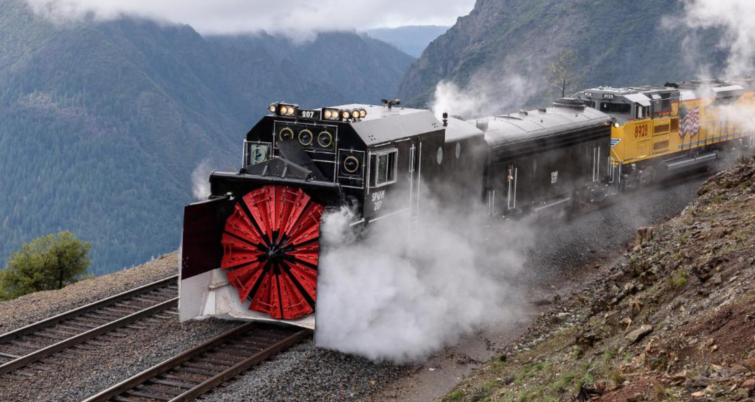Watch: Union Pacific’s ‘Sierra Snow Fighters’ Keep Service Running in California
Written by Union Pacific Corporate Communications
When Union Pacific Railroad senior manager Mike Upton encounters a news crew from The Weather Channel in downtown Truckee, California, he knows it's all hands on deck in the Sierra Nevada Mountain range.
Upton, who manages track maintenance, and his fellow “Sierra Snow Fighters” are in charge of clearing the tracks and keeping the trains running in one of North America’s snowiest stretches of railroad track.
The scope of their work can be summed up in one metric: 38 feet, the average snowfall at Donner Summit. The location is one of the unit’s highest points.
“We are a proud, get-it-done railroad team. While everyone else is waiting for the storm to pass or the highways to reopen, our Union Pacific crew is out there clearing the tracks with some of the biggest, baddest machines in the snow-moving business,” Upton said.
The team takes pride in a long track record of uninterrupted service. “Service on this mountain hasn’t stopped since 2011,” Upton said.
Throughout the season, the team moved or cleared 310 inches of wet, heavy snow, also known as “Sierra Cement,” including 138 inches in December.
Upton and his team are one of several UP snow-fighting teams that work to keep the nation’s supply chain moving during extreme snowstorms such as those in Wyoming, Idaho, Oregon, and Minnesota.
The Sierra Snow Fighters maintain the 245-mile track from Reno to Roseville, which connects sea level in the Sacramento Valley to the 7,000-foot summit at Norden, California. On their section of the track, which crosses the Interstate 80 corridor 23 times, there are more than 700 curves.
The Sierra Snow Fighters will tackle roughly a dozen storms, if not more, during a typical winter season, which begins in early November and lasts until April, according to Upton.
“When Interstates are closing, and trucks are being forced off the road, railroads are able to run thanks to the men and women at Union Pacific who brave the elements and keep our tracks open. Our crews’ commitment and efforts on the ground to keep the lines cleared during extreme weather is a testament to the tenacity of railroaders,” said Jeremy Ritch, general director – Maintenance of Way, Operating.
In 2011, nearly 58 feet of snow fell in the Sierra Nevada, burying the mountain and halting train movement for six days.
UP hired an “avalanche team,” which works to reduce risk and exposure by intentionally triggering safe, controlled avalanches. The railroad also bought specialized snow cats favored by ski resorts, including the PistenBully 600w Polar that can climb and get the crew to remote sections of the mountain.
A Flanger, a piece of snow-removal equipment that uses “flanger blades” to clear the snow and ice between the rails, is the team’s first line of defense. Specially equipped locomotives pull the flanger, which resembles a caboose, UP said.
The team also has nine snow cats, which are high-powered snow tanks used to navigate through the snow and reach remote areas on the mountain. The cats are used for a variety of snow removal tasks, including pushing snow away from the track’s side.
“With the amount of snow we have, if we don’t move the snow away from the tracks, we get “bermed in,” with no place to put the snow that accumulates off the tracks,” said Upton.
A “spreader,” a specially designed piece of equipment outfitted with a plow in the middle and 16-foot snow blades or “wings” on each side, is another tool in their snow-fighting tool chest. Spreaders are used to move snow away from the tracks by plowing through it. They are usually used in pairs, with a spreader in front and a spreader in back of a “train” powered by two locomotives in the middle, UP said.
The Spreader pushes through several feet of snow with its wings, creating an enormous cloud of snow.
When crew members are in the Spreaders, it is the heat, not the cold, that causes problems. It’s warm enough inside the locomotives’ cabs to keep the windows and windshield wipers from freezing and/or icing over, and crews are frequently forced to shed the layers of clothing they wear outside.
“The spreaders are designed to work in blizzard conditions all night and all day long and they run hot,” said Upton.
The Rotary snowplow, the last line of defense in UP’s snow-fighting toolbox, is a massive snow blower with a large circular set of blades that can blow the white stuff 100 to 300 feet away from the tracks, depending on the weight of the snow.
Rotary snowplows are only used when the Flangers, Spreaders, and snow cats ar not able to handle the job and the snow is too high and too close to the track. “It’s a judgement call, but they aren’t sent up the mountain until the snowbanks on the sides of the track are eight to twelve feet high,” UP said.
“They are extremely slow-moving machines, and it takes a lot of work hours to get them up and running,” said Jeff Collins, Senior Manager – Operations, in Sparks Nevada.
The last time the rotary snow plows were used was in the winter of 2018 into 2019 over Donner Pass, Collins said.





